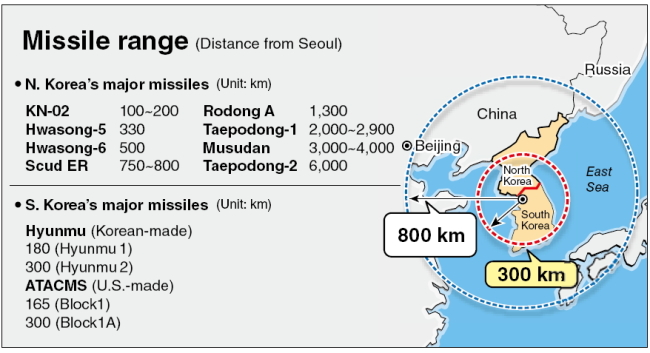Seoul to get more powerful, longer-range ballistic missiles
Seoul and Washington have agreed on revising a bilateral guideline to allow South Korea to develop more powerful ballistic missiles with a range of up to 800 km, up from the previous 300 km, Cheong Wa Dae said Sunday.
The revision is expected to strengthen deterrence against North Korea as the maximum range, from South Korea’s central region, covers all military sites in the communist state.
The weight of the payload is to remain at 500 kg when the range is 800 km, but it can increase proportionately should the range decrease, the presidential office said. Under a “trade-off” principle, the weight could more than triple if the range is at 300 km.
The allies have also agreed to raise the ceiling on the payload weight of unmanned aerial vehicles to 2,500 kg, up from the previous 500 kg, giving a boost to Seoul’s efforts to acquire advanced surveillance and combat aircraft.
“Our government delivered to the U.S. government the revision to the 2001 missile guideline on Oct. 5,” Chun Young-woo, senior presidential secretary for foreign affairs and security, told a press conference at Cheong Wa Dae.
“This is the outcome that resulted from the combination of the best South Korea-U.S. relationship, personal friendship between their leaders, and trust and partnership between the allies.”
Chun added South Korea has now secured “effective, various means” to secure the life and safety of our people by promptly neutralizing nuclear and missile forces in case of North Korea’s armed attack or provocation.
The allies did not make any agreement over restrictions on Seoul’s development of civilian-purpose solid-fuel rockets as the recent negotiations focused on ways to better deal with North Korea’s nuclear and missile threats, he explained.
“We shared the understanding that we will discuss the civilian rocket issue later at an appropriate time,” he said.
Seoul notified China, Russia and Japan in advance of the guideline revision, Chun said without elaborating on their responses.
South Korea has long pushed for the revision of the guideline ― first forged in 1979 and amended in 2001 ― as it does not reflect the changing security environment where neighboring states including the North have increasingly formidable missile capabilities.
Seoul initially suggested that the range be extended to around 1,000 km to put core military targets in the North within striking range.
It particularly underscored the need for stronger self-defense as it prepares to retake wartime operational control from Washington in December 2015, after which the South would take a leading role in the case of a war, with the U.S. providing support.
But Washington was apparently reluctant as the revision could undermine its global initiatives of non-proliferation and arms control, and could provoke China, Russia and Japan, not to mention the North.
Analysts say that the U.S. might have been uncompromising as the revision could prompt other partners with similar missile deals to seek their own amendment. Instead, it argued the South could rest assured as the U.S. assets under the allies’ combined forces can effectively handle North Korean threats.
Experts welcomed the revision, stressing that longer-range missiles would become South Korea’s strategic military assets to deal with changing security conditions in East Asia.
“Washington appears to have made much concession as the 800 km range extends to some neighboring states,” Yang Uk, a senior research fellow at Korea Defense and Security Forum, told The Korea Herald.
“Aside from North Korea, as China becomes more aggressive, having recently launched its first aircraft carrier into service, the U.S. might have relaxed the missile limit for Seoul.”
The UAV-related change has paved the way for Seoul’s acquisition of advanced unmanned surveillance drones and combat aircraft.
With an aim to deploy them in 2021, the South Korean military has recently launched a 500 billion won ($447 million) project to indigenously develop an unmanned combat aerial vehicle.
It has also sought to acquire an unmanned surveillance plane such as the Global Hawk spy drone to enhance intelligence capabilities ahead of the OPCON transfer. The largest drone, Global Hawk, is capable of carrying a payload weighing up to 2,268 kg.
The guideline was forged in 1979 as South Korea sought to bolster self-defense capabilities to better handle North Korean threats. It initially limited the range to 180 km while banning Seoul from mounting a payload weighting more than 500 kg to block the use of nuclear warheads.
As the South needed core technology and components for its missile development amid its heavy diplomatic and economic dependence on the U.S., it could not help but comply with the guideline, analysts say.
Security concerns had also grown deeper in the late 1970s as then U.S. President Jimmy Carter with his signature human rights-based foreign policy had some friction with then general-turned-President Park Chung-hee and moved to withdraw American troops from the peninsula.
As the North and other surrounding nations continued to enhance missile capabilities, Seoul increased its calls for the revision or abolition of the guideline. After years-long negotiations with the U.S., the allies agreed in 2001 to extend the range to 300 km.
With the limits, Seoul has instead focused on developing cruise missiles. But the missiles are much slower and, thus, easier to intercept.
Despite the 2001 revision, South Koreans’ calls for the range extension have persisted due to the growing “missile gap” of some two decades with North Korea.
North Korea succeeded in test-firing a Rodong ballistic missile with a range of 1,300 km in 1993. It has already deployed its longest-range ballistic Musudan missile with a range of 3,000-4,000 km since 2007. The Musudan, in theory, brings Guam, a key U.S. strategic base in the Asia-Pacific region, within its range.
The Taepodong-2 missile is the North’s longest missile under development. It is presumed to have a range of more than 6,700 km, enough to hit parts of Alaska, but still short of reaching the U.S. mainland. The missile’s tests are believed to have failed.
By Song Sang-ho (
sshluck@heraldcorp.com)








